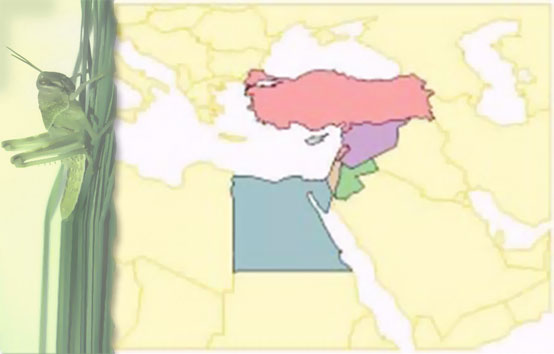Hyalesthes obsoletus Signoret
Common name:
Systematic position: Insecta, Hemimetabola, Hemiptera, Auchenorrhyncha, Cixiidae.
Distribution: Europe, Middle East and Iran.
Morphology: Mature nymphs about 3 mm in length, with wing pads. Adults 4-5 mm in length, body mostly black, wings hyaline with dark patches.
Host plants: In Europe Convolvulus arvensis L., Plantago lanceolate L., Polygonum aviculare L., Urtica dioica L. and Lavandula angustifolia Mill. are the preferred hosts, along with about 20 others. In the Middle East the shrub Vitex agnus castus L. is a favorite plant. Grapevines are infested only accidentally, as the young H. obsoletus cannot develop on these hosts.
Life history: Females produce several hundred wax-covered eggs, and the progeny, which mostly feed on roots, require several months to mature. In Europe they prefer U. dioica over other host plants, whereas in Israel they occur in large numbers on V. agnus castus. The adults are most active in autumn and usually fly in late afternoon, and do not disperse widely, preferring to stay on their initial host plants.
Economic importance: Hyalesthes obsoletus is a vector of a stolbur phytoplasma that causes the grapevine disease known as “Bois noir”, “Legno Nero” or grapevine yellows. It is accidentally transmitted to grapevine by insects that had developed on more-preferred nearby plants. The disease reduces lignified shoots and results in shrivelled grapes and rolled leaves. Although only a third of the insects carry the disease, the rapid ability of H. obsoletus to transmit it to grapevines (within 3-6 hours of feeding) makes the insect a dangeous vector. In an heavy infestation about half the vines may be affected. The importance of grapevine yellows has greatly increased in Europe during the last decade.
Hyalesthes obsoletus also vectors several other plant diseases, such as an important phytopalsma to potatoes in Serbia.
Management
Monitoring: Trapping on transparent or yellow sticky traps.
Horticultural methods: In Europe H. obsoletus raises large populations on U. dioica. Herbicide treatments or cuttings of this plant reduce vector populations in and around vineyards. In Israel the pest is strongly attracted to V. agnus castus. Potted plants of that shrub, placed around vineyards, attracted the pest and thereby significantly reduced its numbers on adjacent grapevines.
References
Bressan, A., Turata, R., Maixner, M., Spiazzi, S., Boudon-Padieu, E. and Girolami, V. 2007. Vector activity of Hyalesthes obsoletus living on nettles and transmitting a stolbur phytoplasma to grapevines: a case study. Annals of Applied Ecology 150: 331–339.
Johannesen, J., Lux, B., Michel, K., Seitz, A. and Maixner, M. 2008. Invasion biology and host specificity of the grapevine yellows disease vector Hyalesthes obsoletus in Europe. Entomologia Experimentalis et Applicata 126: 217-227.
Kehrli, P. and Delabays, N. 2012. Controlling ‘bois noir’ disease on grapevine: does the timing of herbicide application affect vector emergence? Journal of Applied Entomology 136: 234–237.
Kessler, S., Schaerer, S., Delabays, N., Turlings, T.C.J., Trivellone, V. and Kehrli, P. 2011. Host plant preferences of Hyalesthes obsoletus, the vector of the grapevine yellows disease ‘bois noir’, in Switzerland. Entomologia Experimentalis et Applicata 139: 60-67.
Klein, M. (and 7 co-authors) 2001. Monitoring phytoplasma-bearing leafhoppers/planthoppers in vineyards in the Golan Heights, Israel. Journal of Applied Entomology 125: 19-23.
Mori, N., Pozzebon, A., Duso, C., Reggiani, N. and Pavan, F. 2016. Vineyard colonization by Hyalesthes obsoletus (Hemiptera: Cixiidae) induced by stinging nettle cut along surrounding ditches. Journal of Economic Entomology 109: 49-56.
Orenstein, S., Zahavi, T., Nestel, D., Sharon, R., Barkalifa, M., and Weintraub, P.G. 2003. Spatial dispersion patterns of potential leaf hopper and planthopper (Homoptera) vectors of phytoplasma, and their associated phytoplasmas, in wine vineyards. Annals of Applied Biology 142: 341-348.
Mitrović, M. (and 6 co-authors) 2016. ‘Candidatus phytoplasma solani’ genotypes associated with potato stolbur in Serbia and the role of Hyalesthes obsoletus and Reptalus panzeri (Hemiptera, Cixiidae) as natural vectors. European Journal of Plant Pathology 144: 619-630.
Sforza, R., Bourgoin, T., Wilson, S.W., and Boudon-Padiew, E. 1999. Field observations, laboratory rearing and descriptions of immatures of the planthopper Hyalesthes obsoletus (Hemiptera: Cixiidae). European Journal of Entomology) 96: 409-418.
Zahavi, T., Peles, S., Harari, A.R., Soroker, V. and Sharon, R. 2007. Push and pull strategy to reduce Hyalesthes obsoletus population in vineyards by Vitex agnus castus as trap plant. Bulletin of Insectology 60: 297-298.
Website
